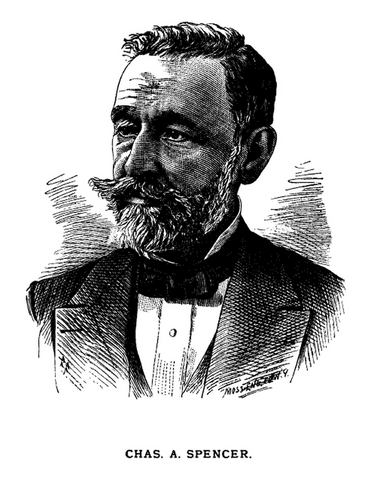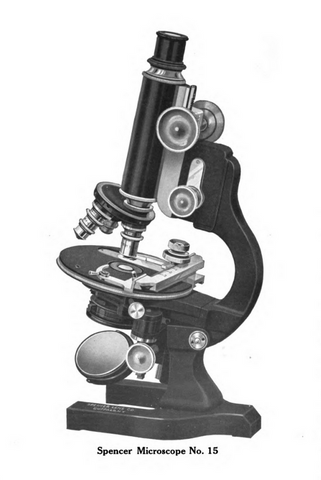
“Mr. Spencer was, in the truest acceptation of the word, a genius. Life was not to him a contest for the possession of what the world commonly calls gain; no man was ever more indifferent to this than he.”
– Hamilton L. Smith 1882, American Professor, Biologist, and Photographer
It is generally quite reductive to attribute the formation of any particular field to the actions of just a singular individual. Typically, such views of history oversimplify the course of events and have a tendency to skip over the many small contributions that enabled significant change to happen. At the same time, it is important not to undersell the great waves that certain individuals in history can make around them, and indeed, it would be only a fragmentary telling of the development of the American optical industry to go without mentioning the immense contributions of Charles A. Spencer. Spencer was a painstakingly detail-oriented figure, someone utterly committed to perfecting his work, yet, endeavoring to go beyond all the same, leaping into the pit of curiosity that is the world of scientific discovery.
Spencer was born in 1813 in the small town of Quality Hill, Lenox, New York to parents Ichabod Spencer and Mary Smith, his father having served as an officer of the United States Army during the War of 1812. He began his studies at the Cazenovia Academy, subsequently graduating to Hobart College before switching to Geneva and then, finally Hamilton College in Clinton, New York. Early on, Spencer is said to have expressed his aptitude for scientific discovery apocryphally, though certainly in character, by constructing his first lens at barely twelve years old. In a written memoir for the American Society of Microscopists, of which, Spencer was made an honorary member2, fellow microscopist and pioneering American scientist, Hamilton L. Smith described Spencer as exceptionally industrious, even from a young age.
“There is in existence a portrait of him, taken when he was but sixteen years old, and which must have been a very truthful likeness, for it shows clearly the character of the future man. He is looking straight forward with fearless eye, and already reading on the scroll of fame with the name of Charles A. Spencer.”
– Hamilton L. Smith
Dissatisfaction with his education arose in young Spencer however, owing partially to an apparent lack of focus from the college on the scientific subjects that sparked his interest and to Spencer's own feeling of guilt as a self-described “charity student” with his uncle serving as one of the trustees of Hamilton. Leaving the college, Spencer endeavored on his own to continue his studies in the sciences and eventually develop his own scientific instrument company. It should be noted that the American optical industry as Spencer would discover it in the early 1800s was one dominated by imported instruments and parts. Spencer would be entering a space where he would need to develop an edge against the established optical manufacturers of Europe for selling in the American market. Though precise details in sources on Spencer’s life can be sparse, around 1838, Spencer entered the optical industry in partnership with his cousin, Hamilton Spencer, as a producer of fine telescopes and microscopes, operating out of a workshop in Canastota, New York. It is also at this time that Spencer would marry Mary Morris Stilwell to which they would have several children. Though the partnership with Hamilton Spencer would dissolve in the years immediately following after a lack of financial success, Charles Spencer would continue working in the optical field, particularly towards the development of achromatic lenses.
These types of lenses, thus far pioneered by Charles Chevalier and Georges Oberhauser in Europe, corrected two principal distortions found in single lenses, chromatic and spherical aberration. The former originates from a lens refracting different wavelengths to different focal lengths, producing a skewed color effect, the latter from light refracting at a different angle depending on the position it hits the lens, lowering overall image quality. Spencer would ultimately succeed in manufacturing lenses that corrected for these distortions, with his craftsmanship being such that some even theorized that his success might come from the discovery of some new type of glass. Instead, however, Spencer's success lie in simple but careful manufacture of his optical products, a practice that began to earn Spencer praise in the optical field.
In his memoir on Spencer’s life, Hamilton Smith wrote, “in 1847, when Spencer made for Dr. Gilman, of New York… there were not over four or five achromatic microscopes in the City of New York. Dr. Gilman, having showed to Mr. Spencer one of these, a Chevalier, Mr. Spencer remarked that he thought he could make a better one, and the doctor decided to let him try”. From his efforts, Spencer’s creation astounded Dr. Gilman for its clarity in observing even the most difficult of test materials. Specifically, Spencer later noted in a letter that his scope, though not the best he knew himself capable of making, was well suited to observing the longitudinal striae of the diatom Navicula hippocampus, a form of microalgae and notable benchmark of microscopic observational power at the time. By the following year, Spencer’s microscope optics would come to great renown, being referred to in a letter to the editors of the American Journal of Science by famed microscopist Jacob W. Bailey as far superior to any of French design and of the same caliber as the finest English optics.
Not satisfied with just having reached the benchmark for resolution, Spencer acquired a new sample of diatom collected from the water of the Croton River in New York, one that proved more challenging to resolve under microscopic observation than Navicula hippocampus. Tirelessly working towards meeting the new challenge he set for himself, Spencer eventually produced a new objective capable of resolving the Croton diatom. Spencer sent his materials to Bailey, then a professor of chemistry at West Point, for study, to which the latter gave the name of the new discovery, Navicula Spencerii. Bailey would go on to defend Spencer’s optics in a later publication from critics of the emerging American microscope manufacturer, specifically noting how he sought to correct the notions that “[charge] me with [first] with underrating the English microscopes; [second] with over-rating both the merits of our own artist Spencer, and the difficulties of N. Spencerii as a test object”. To that end, Bailey embraced Spencer’s new microscopes over their European competition, further mentioning an exchange of correspondence with London researchers concerning N. Spencerii, which, with the premier English microscopes available, “could make nothing” of the sample given to them, unlike Bailey with his Spencer scope. Though it did not take long for European microscopists to resolve Spencer’s new benchmark with refinements to their microscopes and test methodology, the commotion generated by the feat firmly cemented Spencer’s name in Europe as one to watch out for.
“Comparing the performances of this objective with the recorded performances of other object glasses which from time to time have appeared in the Journal, I cannot resist the conviction that it is the best objective ever produced, and far the best.”
– Alexander S. Johnson writing for the American Journal of Science and Arts
Indeed, in the years following the N. Spencerii discovery, Spencer would not only come across another new diatom to which his scope alone could resolve, but excel above his European competition in terms of resolving power relatively consistently. Spencer's new challenge and one of his most persistent pursuits through the 1850s and 60s was his quest to produce objectives with greater and greater angles of aperture, that is, angle from focal point to ends of the diameter of the lens. By this point in the 19th century, consensus in the field of microscopy had generally been that objectives with angles of aperture greater than 135° simply did not give the resolving power to see the fine details desired by scientists of the day. However, Spencer remained convinced that objectives with large angles of aperture could be made that could outperform their shallower-angled peers. Spencer would produce a number of such wide-angled objectives, even producing some with an angle of aperture of up to 175°. For his trouble, Spencer would find his hypothesis validated as his wide-angled objectives successfully provided the resolving power he sought, in part, contributing to industry-wide reevaluations of the practice of avoiding objectives using large angles of aperture. Hamilton Smith proposes in his memoir a possible origin for this general misconception then-plaguing microscopy, that being that the process of increasing the angle of aperture was so laborious, step-intensive, and prone to defects that would need to be accounted for that the majority of microscope manufacturers who attempted it stopped before the process was fully refined, accordingly yielding objectives that performed worse than their shallow-angled relatives. To this point, Smith describes Spencer as taking a full two years between initial development of a 170° objective and its satisfactory refinement for sale. Bearing the fruits of his investment, Spencer’s wide-angled objectives brought him to even greater renown, not only as a pioneer of American microscopy, but as a worldwide scientific figure in his field.
In one particularly anecdotal instance of Spencer’s work clearly speaking for itself, there lies the story of Robert B. Tolles, a young man of limited formal education, who, after stumbling upon Spencer’s workshop in Canastota, New York, became so fascinated in the trade that he took it upon himself to make it his own life’s work. Starting in 1843 from his fateful visit, Tolles would become Spencer’s apprentice, creating a number of inventions over the course of tenure and earning the title of pioneering scientist in his own right. Maintaining his apprenticeship for fifteen years, Tolles would operate on his own accord beginning in 1858 before eventually accepting a senior position at the Boston Optical Works. Like Spencer, Tolles worked assiduously on his craft, producing works that were as much intricate pieces of art as they were precisely calibrated pieces of scientific equipment. Though he would be less financially successful than Spencer, Spencer's apprentice would go on in history as a prolific optical scientist with a great many inventions to his name.

By 1854, Spencer had formed a new partnership with A. K. Eaton which served the pair well, especially after securing a number of lucrative contracts including for the construction of the telescope at the Litchfield Observatory at Hamilton College, New York. Then the largest telescope in the country, the project was finished in 1856, awarding $10,000 to Spencer and Eaton. That same year, the pair were awarded the contract for the construction of a heliometer at the Dudley Observatory in Albany, New York. To research his task thoroughly, Spencer embarked on a six-month trip to Europe to study the leading examples then constructed. Though productive in terms of the contacts made and knowledge gained, Spencer's trip would ultimately be a wasted one as the project became sidelined by its patrons. Nonetheless, while the Dudley project faced issues from its patrons, Spencer also bore his own share of difficulties with regards to his business management. Spencer microscopes were well-regarded and his workshop received a good deal of demand, but, Spencer himself began to develop a reputation for tardiness and unfulfilled orders, at one point allegedly amassing "$20,000 to $25,000 or more" in incomplete orders at one time. Despite being the source of his strength as a microscope manufacturer, Spencer's meticulousness in ensuring that every product produced by his workshop met his high standards greatly slowed down production, substantially limiting the growth of his company.
While Spencer’s fortunes had thus far seen him reach notoriety in his field, the fall of 1873 would see Spencer face one of his biggest challenges yet. In the intervening years following the failure of the Dudley Observatory project, Eaton and Spencer separated, with Spencer instead taking up work with his sons in his Canastota workshop. One fall night around 11:00 PM, the building next door to Spencer’s workshop caught fire and became engulfed in flames. Burning through the night until morning, Spencer’s workshop, with its collection of precision instruments and yet-to-be completed products, was entirely reduced to rubble. The fire proved a debilitating loss for the meticulous artisan who had occupied it for decades, but it would not put an end to Spencer’s work. Moving to Geneva, New York in 1875, Spencer and sons began work for the Geneva Optical Company where they stayed for two years before once again moving to independent operations, now adopting the company name C. A. Spencer & Sons. Just as well a reward for a storied career of scientific exploration and pioneering, Spencer’s company was awarded a gold medal at the 1878 Paris Exhibition for their exemplary their microscope objectives. This would be one of Spencer’s final accolades however, with illness taking him after three weeks on September 28, 1881.
Spencer’s legacy would be carried on by his son, Herbert Spencer, who, having left his father’s workshop in 1880 to work independently, establishing the H. R. Spencer Company in Cleveland, Ohio. Still, the field of American optics of Herbert Spencer's day was no longer the desolate industry his father had found. By the late 19th century, other leading local producers of cutting-edge optics had emerged including the famed Bausch & Lomb Optical Company and new European manufacturers had begun to rise in popularity, particularly Carl Zeiss. However, like his father, Herbert’s superb handiwork found a place for his company in the industry, even amid heightened competition. In 1890, Herbert Spencer once again relocated the firm, this time to Buffalo, New York where it would ultimately stay. He further engaged in a partnership with Fred L. Smith, establishing his company under the name Spencer and Smith. Reorganized as the Spencer Lens Company in 1895, the company thrived under the younger Spencer’s leadership, expanding as a prominent American optical manufacturer. Unfortunately, Spencer’s leadership was not to last as he became gripped with illness, passing on February 7, 1900. With the death of the Spencer family, outside expertise was brought in in the form of Hermann Kellner of Zeiss and Carl Dieckmann. Though the loss was quite detrimental for the company, it would recover in time, steadily earning a reputation as a supplier of finely manufacturer optics and scientific instruments.
Nonetheless, the company whose origins lay the foundation of the American optical industry began to be superseded by later additions to the field, most prominently Bausch & Lomb. Foreign optical manufacturers like Zeiss also came steadily increase their hold the American optical field, especially regarding the production of glass for instrument production.

This latter point in particular would become a concern of national security come World War I when German imports would no longer be viable and demand for instrumentation would increase sharply. Hence, in the wake of World War I and the American military's need to ramp up local production of optical glass, both the Spencer Lens Company and Bausch & Lomb experienced an upswell of investment to meet demand. Come the 1920s, the Spencer Lens Company would be producing a variety of optical products, from its original forte in microscopes to optics for photography and projection. However, the company's success would be profoundly shaken by the Great Depression, opening the door for a 1935 purchase by its competitor, the American Optical Company. The Buffalo plant would continue operations under American Optical and microscopes produced by the plant would retain a "Spencer" mark under the American Optical logo for some ten years before ultimately, the company was absorbed fully into American Optical in 1945.
The Spencer Lens Company, its founder, Herbert Spencer, and the pioneering enterprises of his father, Charles A. Spencer all represent the culmination of over one hundred years of effort from a remarkable group of individuals. Spencer, for all his heretofore described genius was constantly supported in his work by a wide cast of people: his son Herbert, Tolles, Eaton, and countless other partners, assistants, and craftspeople that contributed to the sum total of scientific progress. All the same, Charles Spencer’s story remains an inspiring one, and one that offers a microcosmic view of the scientific process in action, the cumulative effect of substantial individual contributions.
Further Reading
- Thomas, John. "I Saw Them Making Microscopes." Buffalo: American Optical Company: Instrument Division, 1937.
A short description of walking through what was once the Spencer Lens Company's facility in Buffalo, New York in 1937 as it existed under the American Optical Company.
Bibliography
- Bailey, J. W. "ART. XXVI.--some Remarks on the Navicula Spencerii, and on a Still More Difficult Test Object;" American Journal of Science and Arts (1820-1879) 7, no. 20 (03, 1849): 265.
- Blackham, Geo. E. “Memoir of Robert B. Tolles.” Proceedings of the American Society of Microscopists 6 (1884): 41–46.
- “Charles A. Spencer.” Scientific American 45, no. 18 (1881): 278–79.
- Gilman, C. R. "Art. XXVII. -- An Account of a Compound Achromatic Microscope, made by Charles A. Spencer of Canastota, N. Y.; by C. R. Gilman, M.D., Professor of Obstetrics, &c., in the College of Physicians and Surgeons, New York." American Journal of Science and Arts 5, no. 14 (03, 1848): 237.
- Johnson, Alexander S. "ART. IV.--Notice of a New Object Glass made by Charles A. Spencer of Canastota, N. Y.;" American Journal of Science and Arts (1820-1879) 13, no. 37 (05, 1852): 31.
- Krauss, William C. “The Debt of American Microscopy to Spencer and Tolles.” Transactions of the American Microscopical Society 23, (1902): 19–30.
- Smith, Hamilton L. “Memoir of Charles A. Spencer.” Proceedings of the American Society of Microscopists 4 (1882): 49–74.
- “Spencer, Charles Achilles.” The National Cyclopedia of American Biography, Vol. XIII, 1906. New York: J. T. White & Company.
- “Wednesday, August 10.” Proceedings of the American Society of Microscopists 3, (1881): 5–14.
- Wills, Stewart. "How the Great War Changed the Optics Industry." Optics and Photonics News 27, no. 1 (2016): 40-47.
